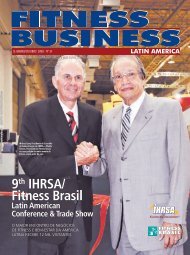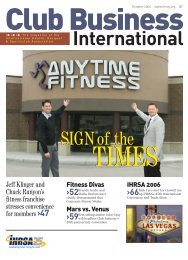Innovations - IHRSA
Innovations - IHRSA
Innovations - IHRSA
You also want an ePaper? Increase the reach of your titles
YUMPU automatically turns print PDFs into web optimized ePapers that Google loves.
Keeping Clubs safe & sound<br />
argument has shifted to being either that the club didn’t<br />
use the AED when it should have, or, if it did use an AED,<br />
that it didn’t do so quickly enough.”<br />
A New York court recently dismissed a case involving the<br />
death of a club member, as the result of complications from<br />
heart failure. The individual involved collapsed while using<br />
a treadmill. Another club member, who’d seen what had<br />
happened, notified a front-desk employee,<br />
who dialed 911 and then searched for a key<br />
to a cabinet holding the AED. A second<br />
employee began administering CPR.<br />
After several minutes, paramedics arrived<br />
and employed their defibrillator during the<br />
course of the emergency response, which,<br />
ultimately, was unsuccessful.<br />
The plaintiff’s estate argued that the failure<br />
to use the club’s AED on the victim in a<br />
timely fashion had caused, or contributed<br />
to, his death. The court, however, held that<br />
heermance<br />
he’d assumed the risk of cardiac arrest by<br />
engaging in aerobic exercise. It also found<br />
that the club was in compliance with its<br />
statutory obligation to have an AED and<br />
trained personnel on-site during business<br />
hours, and that contacting 911 and performing<br />
CPR constituted a reasonable emergency<br />
response. The court thus concluded that the<br />
failure to successfully open the cabinet and<br />
use the AED wasn’t an omission giving rise<br />
to liability.<br />
“As can be seen from this case, health<br />
clubs should undertake to train employees to<br />
perform an adequate emergency response,<br />
Baumgarten<br />
including an immediate telephone call to 911<br />
emergency services and the beginning of CPR<br />
efforts, if necessary,” suggests Heermance. “The use of an<br />
AED, when appropriate, may also be useful.<br />
“However,” he adds, “clubs should understand that<br />
the failure to utilize their AED in response to a cardiac<br />
event isn’t, from a liability standpoint, necessarily fatal,<br />
particularly when other emergency response actions<br />
have been taken immediately. In many jurisdictions,<br />
these beginning steps are enough to protect the club<br />
under applicable good Samaritan statutes.”<br />
use equiPmenT fiTTinGly<br />
Douglas Baumgarten, the president of SportFit Consulting,<br />
based in Aldie, Virginia, points out that many cases of<br />
LIABILITY WAIVErS CAN BE SAVIOrS<br />
38 Club Business International | APrIL 2010 | www.ihrsa.org<br />
fitness-equipment misuse also involve overzealous personal<br />
trainers. “There are some fitness professionals out there<br />
who think that the crazier the exercise, the more it enhances<br />
their reputation as a tough and innovative trainer.”<br />
As a result, he acknowledges, some trainers lead deconditioned<br />
nonathletes to attempt difficult exercises that<br />
may put them at risk of injury.<br />
Baumgarten served as an expert witness in a 2009<br />
Texas case involving a plaintiff who’d fallen off of a popular<br />
training device during a session with a personal trainer<br />
at a gym. She claimed that, as a result, she’d fractured<br />
both wrists and suffered other injuries. The plaintiff sued<br />
the gym; the trainer, for having her use the device in a<br />
manner not recommended by the manufacturer; and<br />
the manufacturer, charging that the warnings on the<br />
equipment were inadequate since the company knew<br />
trainers were misusing the device.<br />
The jury found no negligence or product defect on the<br />
part of the manufacturer, but it concluded that the trainer<br />
was 85% negligent, and the plaintiff, herself, 15% negligent.<br />
It could have awarded her as much as $1,818,575, but,<br />
because of a high-low agreement reached before the onset<br />
of the trial, the award was capped at $1 million.<br />
The lesson here is simple, says Baumgarten: “Use<br />
equipment in the way it was intended—if you don’t,<br />
you’re liable.”<br />
mAinTAin ProPerTy ProPerly<br />
A liability waiver, as important and valuable as it is,<br />
typically won’t protect a club if it fails to maintain its<br />
facilities properly. This was demonstrated in 2006, when<br />
a California court ruled that a waiver didn’t protect a club<br />
from liability for injuries suffered by a patron who’d fallen<br />
on a pool deck made slippery by the growth of algae. “The<br />
risk of algae growing on the pool deck, causing it to<br />
become dangerously slippery, is not inherent in the sport<br />
itself, and is not a risk assumed by those who utilize the<br />
swimming pool, so as to relieve the pool owner of the duty<br />
to keep the deck clean,” the court wrote.<br />
“In California, as a general rule, courts will only uphold<br />
a waiver if the type of injury suffered by a member is contemplated<br />
by use of the equipment and services,” explains<br />
Gary Bradley, Esq., a partner at Bradley & Gmelich in<br />
Glendale, California. “While pulling a muscle while using<br />
the treadmill would qualify, slipping on algae around a<br />
club’s pool—wouldn’t.” —|<br />
– Kristen Walsh, kwalsh@ihrsa.org<br />
A key component of any club’s risk-management program is a carefully crafted and unambiguous<br />
liability waiver. “The primary function of the waiver is to protect the provider from liability for negligence,<br />
and, when used in the correct circumstances, waivers can provide liability protection in at least 45 states,”<br />
according to Doyice J. Cotton and Mary B. Cotton, whose Waivers & Releases of Liability, 7th edition, is based<br />
upon more than 1,000 recreation-related cases. (This book is available at www.ihrsastore.com.) —|
















